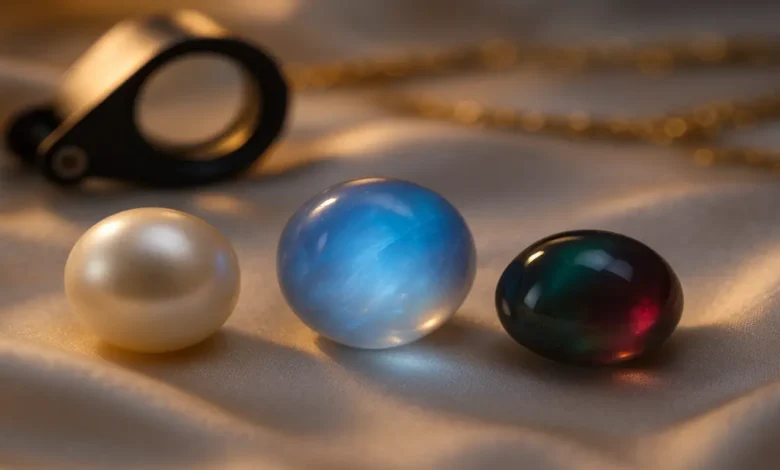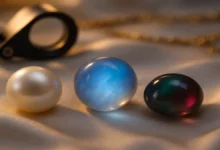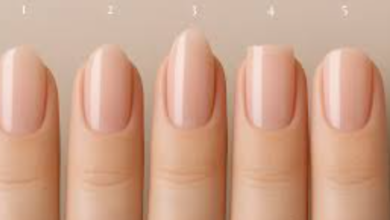Gem for June: The Complete Birthstone Guide

Explore the magic behind the “gem for June” — from pearls to moonstone and alexandrite. Learn about meanings, care, history, choosing the right stone, and more in this expert, easy-to-read guide.
The gem for June holds a special allure because this month is blessed with not just one, but three remarkable stones — pearl, moonstone, and alexandrite. Each has its own charm, origin, and symbolism, representing the diversity and complexity of those born in June. Unlike many other months that claim only one official birthstone, June’s trio captures elegance, mystery, and transformation.
Pearls shimmer with timeless beauty, moonstone glows with mystical calm, and alexandrite fascinates with its color-changing magic. Together, they tell a story of balance between purity, intuition, and wonder. This in-depth guide explores each gem’s origin, meaning, care, styling, and how to choose the one that resonates most with your spirit.
The Uniqueness of June Birthstones
June stands apart because of its three official birthstones — each one reflecting different moods and personalities. While most months feature a single gem, June offers variety and choice. This diversity comes from centuries of cultural evolution, gem discoveries, and symbolic associations tied to different eras.
Pearl has long been adored for its natural purity. Moonstone became a favorite during the Art Nouveau period for its soft glow and feminine energy. Alexandrite, the rarest of the three, was discovered in the 19th century and quickly became a symbol of transformation and royalty. Together, they give June-born individuals the rare privilege of choice.
These stones also span different price ranges and durability levels — pearls being delicate and organic, moonstones mystical yet affordable, and alexandrite rare and luxurious. Whether you’re drawn to vintage elegance or modern minimalism, there’s a June gem for every style and story.
Pearl: The Classic Gem for June
Symbolism and History
Pearl is the oldest known gem, admired by civilizations from ancient China to ancient Rome. Often associated with the moon and water, pearls symbolize purity, wisdom, and serenity. Their organic origin — formed inside oysters and mussels — gives them a life-like energy. Ancient myths even described pearls as “tears of the gods,” representing emotional clarity and love.
In modern symbolism, pearls stand for honesty, loyalty, and peace. Brides wear pearls as a sign of virtue and new beginnings. They’re also believed to promote calmness, self-confidence, and spiritual balance — qualities perfectly aligned with June’s tranquil summer energy.
Formation and Types
Unlike other gems mined from the earth, pearls form biologically. When an irritant enters a mollusk’s shell, the creature coats it with layers of nacre, eventually forming a luminous gem. The result is a natural masterpiece that requires no cutting or polishing.
The main types of pearls include:
- Natural pearls: Rare and formed without human help.
- Cultured pearls: The most common, grown with human-assisted seeding.
- Freshwater pearls: Found in lakes and rivers, often with irregular shapes.
- Saltwater pearls: From oceans, known for higher luster and roundness.
Appearance and Quality
Pearls vary in color — white, cream, pink, gold, black, or silver — depending on the mollusk and environment. The key quality factors are luster, surface quality, shape, size, and color. A perfect round, mirror-like pearl with deep luster commands the highest value.
Despite their softness (2.5–4.5 on the Mohs scale), pearls are treasured for their soothing glow and timeless charm. They’re not just jewelry; they’re heirlooms passed down through generations.
Style and Usage
Pearls are the definition of elegance. From simple studs to layered strands, they adapt beautifully to every look. Modern designers now pair pearls with gold chains or geometric metal designs, transforming a traditional gem into a fashion statement. You’ll find them on runways, in bridal sets, and even in minimalist daily wear.
A single pearl pendant adds grace to any outfit, while multi-strand necklaces create a regal aura. Whether paired with jeans or evening gowns, pearls always whisper sophistication.
Quick Summary Table
| Pros | Cons |
|---|---|
| Timeless and elegant | Soft and prone to scratches |
| Affordable options available | Sensitive to chemicals and perfumes |
| Pairs beautifully with any metal | Requires gentle care |
Moonstone: The Dreamy Gem of Light
Myth and Meaning
Moonstone is a gemstone of intuition, mystery, and inner harmony. Its enchanting glow, known as adularescence, resembles the moonlight shimmering on water. Ancient civilizations believed moonstone was created from solidified moonbeams, holding lunar magic and feminine energy.
Spiritually, moonstone enhances emotional intelligence and calmness. It’s considered the “stone of new beginnings,” guiding wearers through life transitions. Many associate it with love, luck, and creativity — qualities that resonate deeply with June’s nurturing and imaginative spirit.
Formation and Variety
Moonstone belongs to the feldspar mineral group, composed of thin layers that scatter light. When the layers are perfectly aligned, they produce a floating, ethereal glow. The most prized moonstones are nearly colorless with a vivid blue sheen, though others display peach, gray, green, or rainbow hues.
It’s found in Sri Lanka, India, Madagascar, and parts of the United States. Each region produces slightly different appearances, but all share that distinctive mystical glow.
Beauty and Quality Factors
When buying moonstone, consider these key aspects:
- Clarity: The more transparent, the better.
- Adularescence: The strength and position of the glow.
- Color: Blue sheen is most valued.
- Cut: Cabochon cuts bring out the best optical effects.
Moonstone measures 6–6.5 on the Mohs scale, making it more durable than pearl but still softer than many other gems. With care, it can last a lifetime.
Fashion and Style Appeal
Moonstone’s magical sheen makes it ideal for both modern and bohemian aesthetics. It looks stunning in silver, rose gold, or yellow gold. Many designers combine moonstone with smaller accent gems like diamonds or sapphires to create dreamy contrast.
Rings, earrings, and pendants featuring moonstone radiate a celestial, romantic aura. It’s perfect for those who appreciate subtle shimmer and soulful charm rather than bold sparkle.
Quick Summary Table
| Pros | Cons |
|---|---|
| Mystical glow with soft beauty | Moderate hardness; can scratch |
| Affordable compared to rare gems | Adularescence varies between stones |
| Symbolic and spiritual | Requires careful handling |
Alexandrite: The Rare Color-Change Wonder
History and Mystery
Alexandrite is one of the rarest and most intriguing gemstones known. It’s famous for its ability to change color under different lighting — appearing green in daylight and red or purplish in incandescent light. This optical phenomenon symbolizes balance, transformation, and duality.
Discovered in the 1830s in Russia’s Ural Mountains, alexandrite was named after the future Tsar Alexander II. Because its colors mirrored the Russian imperial flag, it quickly became a symbol of royalty and prestige. Its rarity and color-shifting magic make it a collector’s dream and a luxury choice for June’s birthstone.
Physical Traits and Composition
Alexandrite is a variety of chrysoberyl that owes its chameleon-like behavior to trace amounts of chromium. It’s relatively hard (8.5 on the Mohs scale) and thus suitable for rings and daily wear — though finding natural, high-quality stones can be challenging.
Deposits have been found in Brazil, Sri Lanka, India, and East Africa, but fine specimens remain extremely scarce. This scarcity keeps alexandrite among the most expensive and sought-after gems in the world.
Quality and Buying Factors
When evaluating alexandrite, experts focus on:
- Color change strength: A vivid, distinct shift is ideal.
- Color tone: Bright green to rich red transitions are most valuable.
- Clarity: Fewer inclusions mean better brilliance.
- Cut: Optimizes the play of light and color.
- Size: Larger gems are exceptionally rare and command premium prices.
Synthetic alexandrite exists, offering a more affordable option, but connoisseurs prize natural stones for their authenticity and emotional resonance.
Design and Use
Alexandrite’s dramatic personality makes it perfect for unique rings, pendants, or statement pieces. Jewelers often set it with diamonds or white sapphires to emphasize its dual-tone brilliance. Under changing lights, alexandrite appears alive — shifting moods like a living flame.
Because of its rarity, many consider it an heirloom gem or a centerpiece for milestone occasions like anniversaries or special birthdays.
Quick Summary Table
| Pros | Cons |
|---|---|
| Rare and visually stunning | Extremely expensive |
| Durable and practical for jewelry | Risk of imitation stones |
| Symbol of transformation | Hard to source in large sizes |
Comparing the June Birthstones
| Feature | Pearl | Moonstone | Alexandrite |
|---|---|---|---|
| Type | Organic | Mineral (Feldspar) | Mineral (Chrysoberyl) |
| Hardness | 2.5–4.5 | 6–6.5 | 8.5 |
| Appearance | Soft luster | Blue or rainbow glow | Green-to-red color change |
| Symbolism | Purity, wisdom | Intuition, new beginnings | Transformation, power |
| Availability | Common | Moderate | Rare |
| Ideal Use | Everyday elegance | Spiritual or romantic jewelry | Luxury statement pieces |
Each gem tells its own story — pearl offers grace, moonstone offers mystery, and alexandrite offers transformation. Whether you want classic simplicity or a gemstone that feels alive, June’s selection gives you creative freedom.
How to Choose Your June Gem
Selecting your gem for June depends on emotion, lifestyle, and aesthetic taste.
Personality Connection
If you’re drawn to tradition, purity, and timelessness, pearl may be your match. Dreamers and intuitive souls often resonate with moonstone, while bold, adventurous personalities love the drama of alexandrite.
Budget and Purpose
Pearls are affordable and versatile, moonstones offer beauty without breaking the bank, and alexandrite serves as a lifetime investment. For daily wear, choose durability and comfort. For special occasions, prioritize rarity and symbolism.
Metal Pairing
- Pearls look graceful in silver or white gold.
- Moonstones shimmer best with rose or yellow gold.
- Alexandrite shines in platinum or diamond-accented settings.
Occasion and Emotion
Pearls are perfect for weddings and milestones, moonstones for gifts of intuition or transformation, and alexandrite for marking achievements and luxury collections.
Caring for Your June Gemstones
Every gem requires care to maintain its brilliance.
Caring for Pearls
- Clean gently with a damp cloth after each wear.
- Keep away from perfume, hairspray, and lotion.
- Store separately in a soft pouch.
- Avoid submerging in water or ultrasonic cleaners.
Caring for Moonstone
- Wash with mild soap and lukewarm water only.
- Store away from harder stones.
- Avoid sudden temperature changes.
- Protect from scratches by using soft storage.
Caring for Alexandrite
- Clean with mild soapy water and a soft brush.
- Avoid harsh chemicals.
- Store separately to prevent surface wear.
- Periodically check for loose settings.
Proper care ensures your June gem retains its beauty for generations.
Expert Tips for Buying a June Gem
When shopping for June birthstones, think like a gemologist:
- Always inspect under natural and artificial light.
- Ask for origin details and certification for expensive stones.
- Compare multiple pieces before choosing.
- Avoid “too good to be true” deals on alexandrite.
- Trust your emotional connection — gems should feel right, not just look right.
Styling and Modern Jewelry Trends
The modern revival of June gems blends classic beauty with fresh creativity.
- Layered Pearl Looks: Combine long and short strands for chic dimension.
- Moonstone Rings: Popular in celestial and boho styles, often paired with stars or crescent motifs.
- Alexandrite Accents: Featured in engagement rings for couples who love rare, personal touches.
- Mixed Metals: Designers now combine silver and gold with June gems for a bold, modern twist.
- Casual Luxury: Small pearl studs or moonstone pendants elevate daily outfits without overwhelming them.
As fashion embraces individuality, these gems adapt — proving timeless doesn’t mean old-fashioned.
Quotes About June Gems
“Pearls are the voice of the sea — calm, timeless, and deeply feminine.”
“Moonstone holds the quiet mystery of night within its glow.”
“Alexandrite doesn’t just reflect light; it reflects emotion.”
Common Myths and Misunderstandings
- Myth: Pearls are old-fashioned.
Truth: Modern designs make pearls trendy and versatile. - Myth: Moonstone breaks easily.
Truth: It’s softer, but with care, it lasts decades. - Myth: Alexandrite color change is always dramatic.
Truth: Only high-quality natural stones show strong contrast. - Myth: All pearls are white.
Truth: Pearls come in black, gold, pink, and silver too. - Myth: Only women wear June gems.
Truth: Many men now wear moonstone or black pearls as stylish accessories.
FAQs About the Gem for June
Q: What are the three gems for June?
The official birthstones for June are pearl, moonstone, and alexandrite.
Q: Which June gem is most valuable?
Alexandrite is the rarest and most expensive due to its color-changing nature and scarcity.
Q: Can I wear pearls every day?
Yes, but handle them carefully and avoid contact with chemicals or rough surfaces.
Q: Is moonstone good for emotional healing?
Many believe moonstone enhances intuition, calm, and inner growth, making it a favorite for emotional balance.
Q: Why does alexandrite change color?
Its crystal structure absorbs light differently depending on the lighting source, causing a visible color shift.
Q: Can I mix June gemstones together in jewelry?
Absolutely! Mixing pearls, moonstones, and alexandrite can create elegant or artistic combinations.
Conclusion
June’s gems are as versatile as the people born under this month. From the tranquil purity of pearls to the luminous mystery of moonstone and the captivating color play of alexandrite, each gem tells its own story. Whether you seek calmness, creativity, or transformation, June’s trio offers a match for every soul.
The gem for June isn’t just a stone — it’s an expression of identity, emotion, and timeless beauty. Choose yours with care, wear it with pride, and let its magic accompany you through every season of life.





